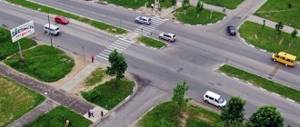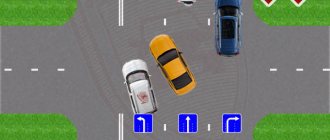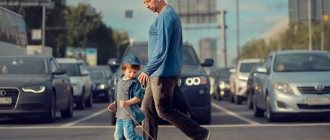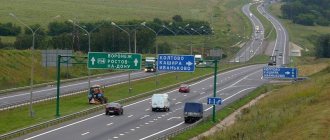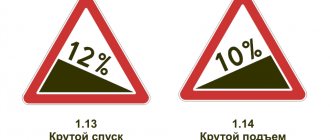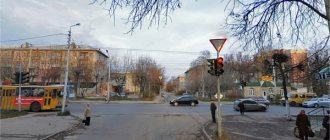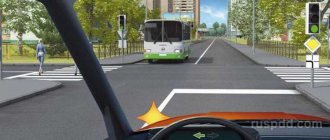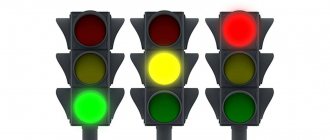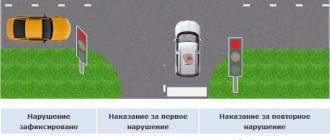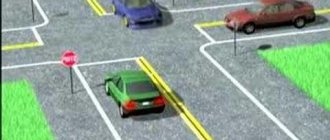Content:
- 1 Rules for driving through intersections in pictures
- 2 Traffic rules: driving through signalized intersections
- 3 Traffic rules: driving through uncontrolled intersections
- 4 General rules for crossing the intersection 2021 4.1 The general rules apply only to trackless vehicles:
Rules for driving through intersections in pictures
13.1.
If a car turns in one direction, it must give way to pedestrians and people riding bicycles who are crossing the roadway on which it wants to turn.
This rule applies to absolutely all intersections. However, some intersections are regulated by special traffic lights for pedestrians and cyclists. In this case, they are required to move when the permission signal is given.
13.2.
According to the traffic rules for driving through intersections, the driver cannot drive to the intersection of the roadway and the intersection zone (marking 1.26) if there is a traffic jam ahead. This will force the driver to stop the vehicle, therefore, traffic for cars moving transversely will be difficult. The exception is turning in any direction.
13.3.
If there is a traffic light or a traffic controller at an intersection, it is called controlled. If a traffic light is showing a yellow flashing or the device is not working, motorists should use the rules that use signs in order of priority.
Thus, priority signs are often installed at intersections, which are the main ones if the traffic light for one reason or another does not work correctly or is completely turned off.
What types of pedestrian crossings are there?
The main and only function of a pedestrian crossing (“zebra crossing”) is to mark the place where pedestrians should cross the roadway. If there is a pedestrian crossing in the visibility zone, then pedestrians are required to cross the road only along it.
Depending on the road situation, pedestrian crossings are divided into:
Adjustable pedestrian crossings.
When traffic is regulated by traffic lights or a traffic controller.
Unregulated pedestrian crossings.
When traffic is not regulated by traffic lights (a flashing yellow signal is turned on or the traffic light is completely turned off), and crossing them is carried out by pedestrians after assessing the traffic situation and being convinced of the safety of crossing the roadway.
Underground and overground pedestrian crossings.
Crossing the roadway along which is carried out regardless of traffic lights or traffic controller signals, as well as the intensity and speed of traffic flow.
The main and only function of a pedestrian crossing (“zebra crossing”) is to mark the place where pedestrians should cross the roadway.
If there is a pedestrian crossing in the visibility zone, then pedestrians are required to cross the road only along it.
Interesting new products have appeared in large Russian cities - a pedestrian crossing made of rubber. The coating of frost-resistant, non-fading, abrasion-resistant rubber creates a slight elevation on the road. Practice shows that clear boundaries of such crossings help pedestrians comply with traffic rules more effectively.
According to the traffic rules, the driver is obliged to give way to people if they start moving or are closer than 2 meters to an unregulated pedestrian crossing, even if they are standing. At the same time, the pedestrian must make sure that it is safe to move by looking to the right and left.
Traffic rules: driving through controlled intersections
13.4.
If it is necessary to turn left or turn around at a green traffic light, the driver must give way to cars moving on the opposite path. Trolleybus and trolleybus drivers are required to follow the same rule.
13.5.
If cars are crossing an intersection and the driver's car is perpendicular when the signal is yellow or red, the motorist is required to give way to other drivers.
13.6.
If the traffic light allows the movement of a rail vehicle and a car, then the driver of the car should let the tram pass. But, in this situation there is an exception: if the driver crosses the intersection and the tram turns right, the driver of the rail vehicle must give way.
13.7.
If a car enters an intersection when the traffic light shows a clear signal, the driver can move in the right direction.
If there are stop lines along the way, the motorist must follow the signal of all traffic lights at the intersection. 13.8.
If the permit signal is working, the motorist must give way to cars that are finishing their movement through the intersection. The same applies to pedestrians who finish crossing the roadway.
Pedestrian crossings. Part 1. Unregulated crossings in Russia
Introduction
This series of articles will look at the pros and cons of various pedestrian crossings in urban environments.
All information was obtained from domestic regulatory and methodological documents and from foreign sources (standards and research in Germany). We will divide all pedestrian crossings into the following types:
- Unregulated pedestrian crossings
- Adjustable pedestrian crossings
- Adjustable diagonal pedestrian crossings
- Pedestrian crossings at different levels: aboveground and underground pedestrian crossings (off-street pedestrian crossings)
- Pedestrian areas
In this article we will consider regulatory documents in Russia for the design of unregulated pedestrian crossings.
Domestic regulatory documents on unregulated pedestrian crossings
The main unpleasant point is that there is no single modern standard that would fully cover the principles of designing unregulated pedestrian crossings. All conditions are spread across several documents.
The main document in the Russian Federation regulating the design of transport infrastructure in cities SP 42.13330.2011 “Urban planning. Planning and development of urban and rural settlements” indicates in paragraph 11.9 that visibility for “vehicle-pedestrian” conditions must be ensured for one of two cases - for a vehicle speed of 25 km/h or 40 km/h. There is no 60 km/h speed at this point. Despite this, in practice there are unregulated pedestrian crossings without a speed limit of 25 or 40 km/h. It is not clear what visibility conditions should be ensured.
Requirement of GOST R 52289-2004 in clause 8.2.6. excluded :
Safety islands, marked on the roadway with markings or curb stones, are installed at surface pedestrian crossings with a vehicle traffic intensity of at least 400 units/hour per lane of the roadway and at a distance between the sidewalk and the edge of the island of at least 10.5 m.
Requirements GOST R 52766-2007:
4.2.5 Safety islands 4.2.5.1 When the vehicle traffic intensity is at least 400 units/hour per one lane of the roadway, at surface pedestrian crossings, safety islands are installed, which are placed on the roadway or dividing strip, with the distance between the edge of the roadway and The border of the island must be at least 7.5 m . 4.2.5.2 The width of the island must be no less than the width of the pedestrian crossing, and the length must be at least 1.5 m. 4.2.5.3 The boundary of the traffic island must be marked using markings and/or curbs. Raised islands with curbs on the roadway are installed in the presence of stationary electric lighting. The height of the curb should be (10 ± 1) cm. When separating oncoming traffic flows by installing barriers along the axis of the roadway, raised traffic islands with curbs are not used. 4.2.5.4 ( Deleted. Amendment No. 1 ). The distance between the edge of the roadway and the border of the island must be at least 7.5 meters for islands marked with markings in accordance with GOST R 52289, and for raised islands with curbs - at least 10.5 meters 4.2.5.5 The center of the island on the roadway must be in alignment of the marking line dividing traffic flows in opposite directions. It is permissible to use the guide island as a safety island . (see figure below) 4.2.5.6 When placing an island on the roadway in front of it, a continuous inclined marking line 1.1 according to GOST R 51256 is applied on both sides, diverting traffic flows from the island (transition line), with an inclination to the road axis of 1:20 (1:50)1). 4.5.2.4 The pedestrian crossing must be equipped with road signs, markings, and stationary outdoor lighting (powered from distribution networks or autonomous sources). On roads with a carriageway width of 15 m or more, surface pedestrian crossings must be equipped with traffic islands in accordance with 4.2.5.
Using a traffic island as a traffic island for crossing one lane of traffic.
Moscow. Nikitsky Gate Square. (Photo: Arkady Gershman, https://gre4ark.livejournal.com/) In addition, GOST R 52289-2004, clause 7.2.14, specifies the conditions for installing traffic lights at pedestrian crossings.
- The intensity of vehicle traffic on the road is at least 600 units/hour (for roads with a dividing strip - 1000 units/hour) in both directions during each of any 8 hours of the working day of the week. The traffic intensity of pedestrians crossing the carriageway of this road in one of the busiest directions at the same time is at least 150 pedestrians/hour. In settlements with a population of less than 10,000 people. vehicle and pedestrian traffic intensity values are 70% of those indicated.
- The traffic intensity values of vehicles and pedestrians under condition 1 are simultaneously 80% or more of those indicated.
- There have been at least three traffic accidents at the intersection in the last 12 months that could have been prevented by traffic lights. In this case, condition 1 must be fulfilled by 80% or more.
And clause 7.3.4. GOST R 52289-2004
Traffic lights P.1 and P.2 (pedestrian) are installed on the sidewalks on both sides of the roadway, and if there is a dividing strip or a raised traffic island - also on them, if the number of traffic lanes in one direction is more than two
If the conditions given above are not met, we have an unregulated pedestrian crossing.
There are legends that after 3 deaths a traffic light is installed. But judging by the third point of the conditions, the minimum intensity of pedestrians should be 120 people per hour in one direction. Otherwise, they have the right not to install a traffic light.
In the “Recommendations for the design of streets and roads in cities and rural settlements” in paragraph 4.41 you can also find a few words about traffic islands: “Islands ensuring the safety of pedestrian traffic are installed with a roadway width of more than 15 m, equal to the width of the central dividing strip. In the absence of a dividing strip, traffic islands with a width of at least 2 m can be created by reducing the traffic lane to 3.25 m on main streets and roads of citywide importance and up to 3 m on main streets and roads of district importance, as well as by using greenery strips and sidewalks ."
The width of the pedestrian crossing marking is selected at the rate of 500 pedestrians per hour per 1 meter of width. But in any case, the pedestrian crossing cannot be narrower than 4 meters. (GOST R 52289-2004 clause 6.2.17).
For country roads, unregulated pedestrian crossings should be installed in accordance with SP 34.13330.2012. Car roads.
Clause 6.6 indicates that unregulated pedestrian crossings are unacceptable on roads of the first category. Clause 6.7 defines the boundaries of the use of pedestrian crossings of various types depending on the intensity of pedestrian traffic (persons/hour - vertically) and the intensity of vehicular traffic (cars/hour - horizontally). Area I is an unregulated pedestrian crossing, II is a controlled pedestrian crossing, III is a pedestrian crossing at different levels (underground or overground).
Areas of application of pedestrian crossings of various types: I - unregulated crossings; II - crossings with traffic light regulation; III - pedestrian crossings at different levels (overground and underground). (Source: SP 34.13330.2012)
There is also an educational document (1977) “Recommendations for regulating pedestrian traffic.” There is a lot of detailed information (including methods for examining pedestrian traffic), but the basic principles of designing pedestrian crossings are not indicated, for example, the maximum permissible width of the roadway for the construction of an uncontrolled pedestrian crossing or the narrowing of the roadway at pedestrian crossing points, the construction of bus stops. Moreover, some points cast doubt on the adequacy of these recommendations as a whole, since they were written for other driving conditions.
conclusions
To summarize, it can be noted that at present there are no mandatory documents that would regulate speed limits at uncontrolled pedestrian crossings (this also applies to country roads). As a result, we get pedestrian crossings marked only by zebra crossings and signs on four-lane highways, along which the driver accelerates in 80% of cases to 80 km/h or more. The picture shows Nepokorennykh Avenue in St. Petersburg with similar traffic conditions (by the way, there is a six-lane street here).
An unregulated pedestrian crossing on a six-lane main street. Saint Petersburg. Avenue of the Unconquered. (Photo: Sergey Davydov, https://transspot.ru/)
When assessing the influence of many factors on the driver, it is difficult to find him guilty of not noticing the pedestrian. Seeing a pedestrian while in the second and third row is problematic, also due to parked cars. It is very difficult to maintain the speed limit on such a street due to the provocative geometry of the road. In addition, at high speed the viewing angle decreases. It is possible to protect a pedestrian with a safety island only if there are four or more lanes on the roads.
Below is a report on deadly crosswalks in St. Petersburg.
In the next article we will look at how safety problems are solved at unregulated pedestrian crossings in Germany.
Update history
2013.11.09 — New publication.
2015.09.15 - Update 1: Post updated due to changes in design standards.
If you find an error, please select a piece of text and press Ctrl+Enter.
Traffic rules: driving through uncontrolled intersections
13.9.
At the intersection of the main and secondary roads, vehicles moving on the secondary road must stop and give way to cars traveling on the main road.
13.10.
If a primary road changes direction, motorists traveling along the primary route must use equivalent road intersection rules.
13.11.
If two equal roads intersect, the driver of the car must give way to vehicles moving on the right. The same applies to rail transport drivers.
Clause 13.11 of the traffic rules for crossing intersections 2021 has an exception: if there is a roundabout at an intersection, the motorist must give way to cars moving along this intersection.
13.12.
If it is necessary to turn left, the driver of the car must give way to other cars heading along the same path from the opposite direction/to the right.
13.13.
If a driver moves through an intersection at night and cannot determine what kind of surface is on the road and does not observe any priority signs, he should assume that he is driving on a secondary road.
